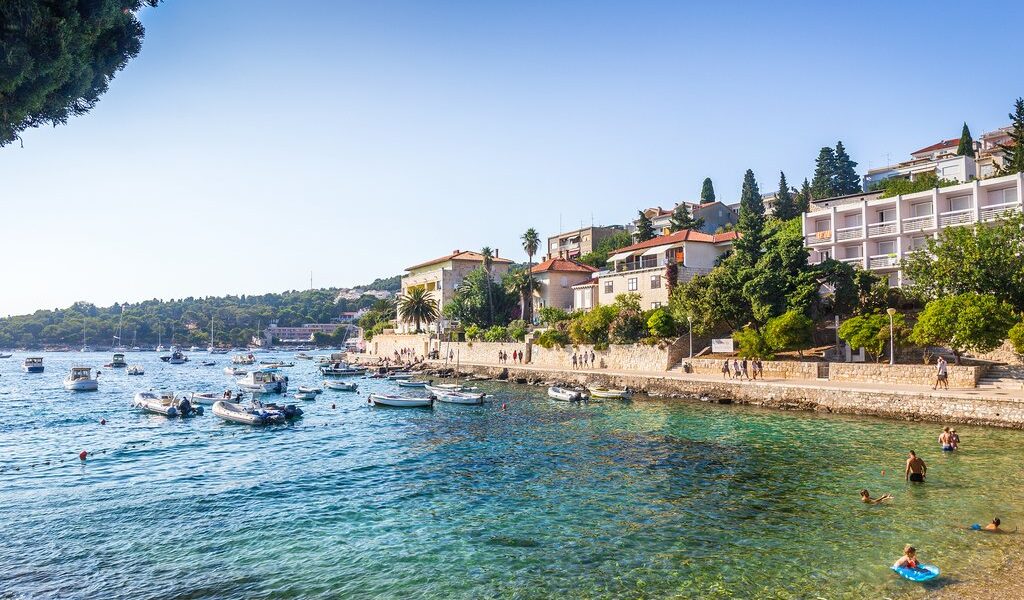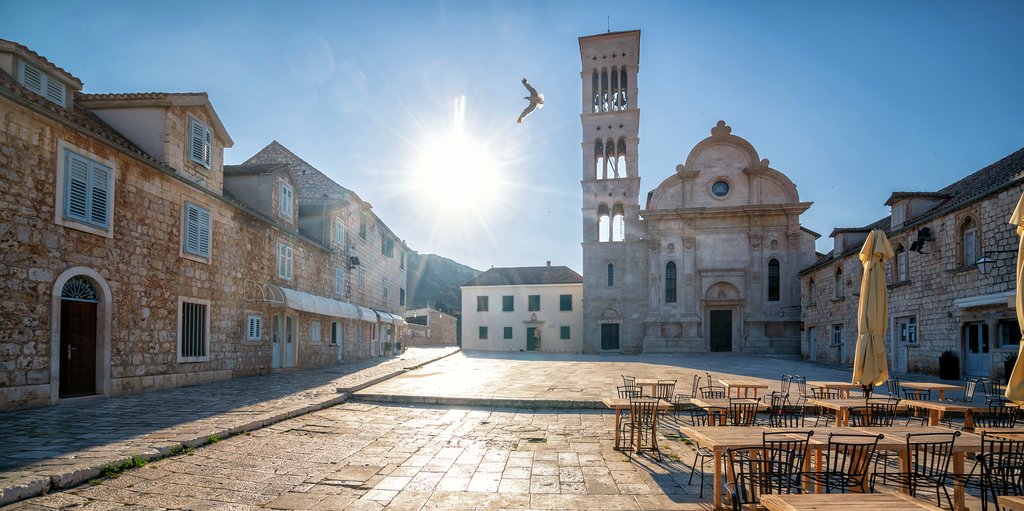
Known for beautiful year-round weather, crisp white and robust red wines, summer nightlife, clear turquoise waters—and active outdoor excursions like kayaking, cycling, and rock climbing, Hvar has become one of the most visited islands in Dalmatia. It’s surrounded by stunning scenery and is rich in culture (it is the only island in the world with four UNESCO World Heritage Sites) where one can easily escape and find the perfect relaxation they need.
## Unveiling the Enchanting Island of Hvar: A Comprehensive Guide
Hvar, a jewel nestled off the Dalmatian coast of Croatia, is an island that effortlessly transcends its well-known image as a vibrant party hub and a celebrity magnet. While its energetic nightlife and glamorous reputation are certainly part of its allure, Hvar offers a far richer tapestry of experiences, woven from unspoiled natural beauty and authentic Dalmatian charm. This Croatian island favorite promises an unforgettable journey for every traveler, from the thrill-seeker to the serenity-seeker.
Venture beyond the glitz and discover a landscape painted with the hues of lavender fields, vineyards basking in the sun, and ancient olive groves whispering tales of generations past. The coastline, a dramatic interplay of rugged inlets and secluded pebbly coves, gently embraces the crystal-clear, azure waters of the Adriatic Sea. Each cove holds a secret, each inlet a promise of adventure.
At the heart of the island lies Hvar Town, the capital. It stands as one of the Adriatic’s most impeccably preserved historic towns, a testament to centuries of culture and heritage. Here, you’ll find an enticing blend of luxury and tradition, with ritzy hotels offering unparalleled comfort, elegant restaurants tantalizing your taste buds with local flavors, and a buzzing nightlife that pulsates with energy. Hvar Town serves as the perfect springboard for exploring the nearby Pakleni islands, a stunning archipelago that beckons with its natural beauty and tranquil waters.
However, to truly experience the essence of Hvar, one must venture beyond the Hvar Riviera along the southern shores. Here, a slower, more authentic Dalmatian way of life unfolds in the charming coastal settlements of Stari Grad, Vrboska, and Jelsa. These towns offer a glimpse into the island’s soul, where time seems to slow down and the rhythms of daily life are in harmony with the sea. For a truly immersive experience, explore the half-abandoned stone villages nestled in the island’s interior, where history lingers in every weathered stone and every sun-drenched alleyway. These villages offer a poignant reminder of the island’s rich past and the enduring spirit of its people.
## Crafting Your Perfect Hvar Itinerary: A Journey of Discovery
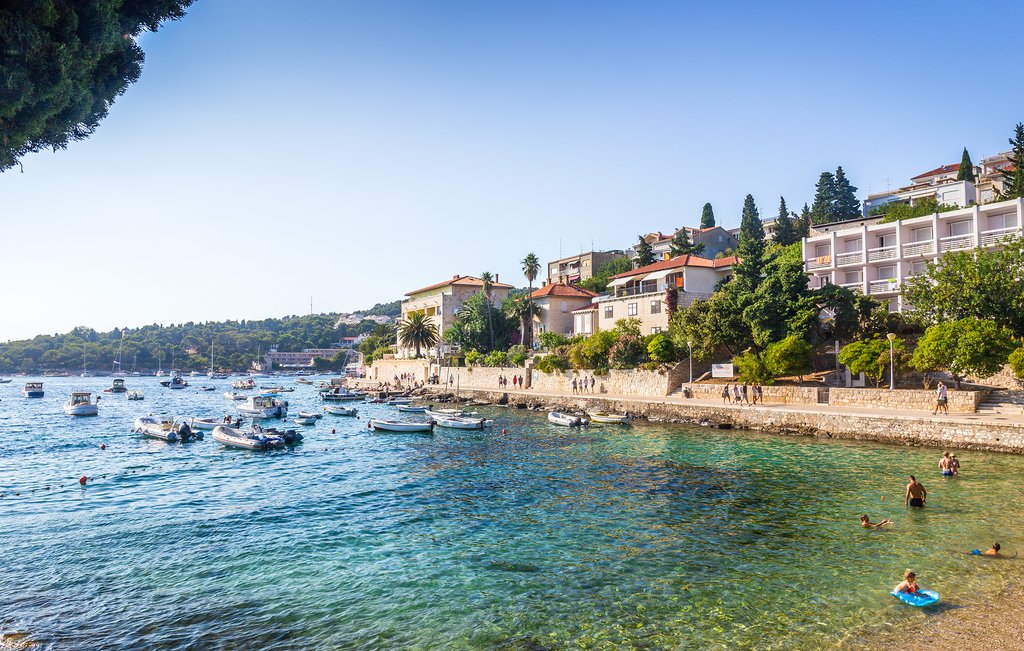
Hvar’s strategic location amidst some of Croatia’s most captivating islands makes it an ideal stop on a sailing adventure through the Adriatic. Imagine yourself gliding across the turquoise waters, the sun warming your skin, as you approach this island paradise. Hvar beckons as a perfect pitstop, offering a taste of its unique charm and vibrant culture.
Consider a meticulously planned itinerary, perhaps a five-day sailing adventure, where you’ll embark on a private vessel in Split and set sail for Hvar. The journey itself is an experience, a symphony of sea and sky. Drop anchor in Hvar Town’s bustling harbor, ready to immerse yourself in the island’s allure. Before settling in for the night, meander through the pedestrianized alleys of the medieval center, a maze of history and charm that will transport you back in time.
The following day, the adventure continues as you sail through the Pakleni archipelago, a collection of stunning islets that seem to float on the water. Stop at your leisure to swim in the crystal-clear bays, snorkel amidst the vibrant marine life, and explore the hidden inlets that dot the coastline. Each island offers a unique perspective, a different facet of the Adriatic’s beauty.
For families seeking a blend of adventure and relaxation, a family-friendly tour promises an unforgettable experience. Imagine spending three nights in Hvar Town, using it as your base to explore the island’s wonders. Kayak to the Pakleni islands, paddling through the calm waters and discovering secluded coves. Bike to the heart of the historic Stari Grad Plain, a UNESCO World Heritage site that showcases the island’s agricultural heritage. And, of course, allow ample time to soak in the cultural delights of the capital, as well as the smaller, picturesque stone settlements that lie beyond, each with its own story to tell.
If you prefer to make Hvar your home base and explore at your own pace, the island offers a diverse range of lodging options. From centrally-located boutique hotels that exude charm and sophistication to more remote and secluded villas that offer privacy and tranquility, you’ll find the perfect haven to suit your needs and preferences.
### The Best Time to Visit Hvar: A Matter of Preference
The question of when to visit Hvar is largely a matter of personal preference, as the island boasts a consistently pleasant climate. Hvar proudly holds the title of Croatia’s sunniest locale, ensuring a warm and inviting experience throughout much of the year.
If you’re drawn to the vibrant party scene and thrive in the midst of energetic crowds, then the peak summer months of July and August are undoubtedly your prime time. During this period, Hvar’s population more than doubles, as visitors from around the world flock to experience its renowned nightlife and bustling atmosphere. However, be mindful that booking reservations and accommodation well in advance is essential, as the demand for hotels and restaurants, particularly in Hvar Town, is exceptionally high.
For those seeking a more relaxed and tranquil experience, the shoulder months of May, early June, and September and October offer an ideal balance of pleasant weather and fewer crowds. During these months, the weather remains sunny with minimal rainfall, and the Adriatic Sea is still warm enough for swimming. You can often find more attractive deals on accommodation and activities during this period. However, it’s wise to maintain some flexibility in your itinerary to and from Hvar, as ferry schedules may be reduced compared to the peak season.
### Reaching Hvar: Your Gateway to Paradise
The most convenient way to reach Hvar is by boat, with regularly scheduled ferry services connecting the island to the mainland and other nearby islands.
Two-hour car ferry rides operate regularly from Split to Stari Grad, allowing you to bring your vehicle and explore the island at your own pace. Passenger-only catamarans offer a faster alternative, whisking you from Split to Hvar Town in just one hour and 20 minutes, or to Jelsa in one hour and 50 minutes.
If you’re traveling from further down the Croatian coast, a three-hour ferry departs from Dubrovnik to Hvar Town, continuing its journey to Split. For those who have rented a car and wish to begin their island exploration immediately, consider boarding a car ferry from Drvenik on the mainland to Sućuraj on the eastern end of Hvar. This short 25-minute ride provides a quick and convenient entry point to the island. However, be aware that lines for car ferries can fill up quickly during the summer months, so it’s advisable to arrive early, especially in August (at least two hours in advance).
In addition to the main ferry routes, there are one to two daily catamarans connecting Hvar to Brač, Korčula, and Lastovo, as well as a weekly catamaran from the tiny island of Vis. However, for a more personalized and flexible experience, consider hiring a speedboat or joining a sailing tour to navigate between these islands.
Once on the island, getting around is relatively easy. Regular buses connect Hvar Town, Stari Grad, Vrboska, and Jelsa, with a dedicated service transporting ferry passengers between the Stari Grad port ferry terminal and Hvar Town (a 30-minute journey).
For those arriving by air, the closest major airports are located in Split and Dubrovnik, with a smaller domestic airport on nearby Brač. However, most travelers opt to fly into the Split airport and then take the short and scenic ferry ride across the glittering Adriatic Sea to Hvar.
## Hvar’s Highlights & Things to Do: An Array of Experiences
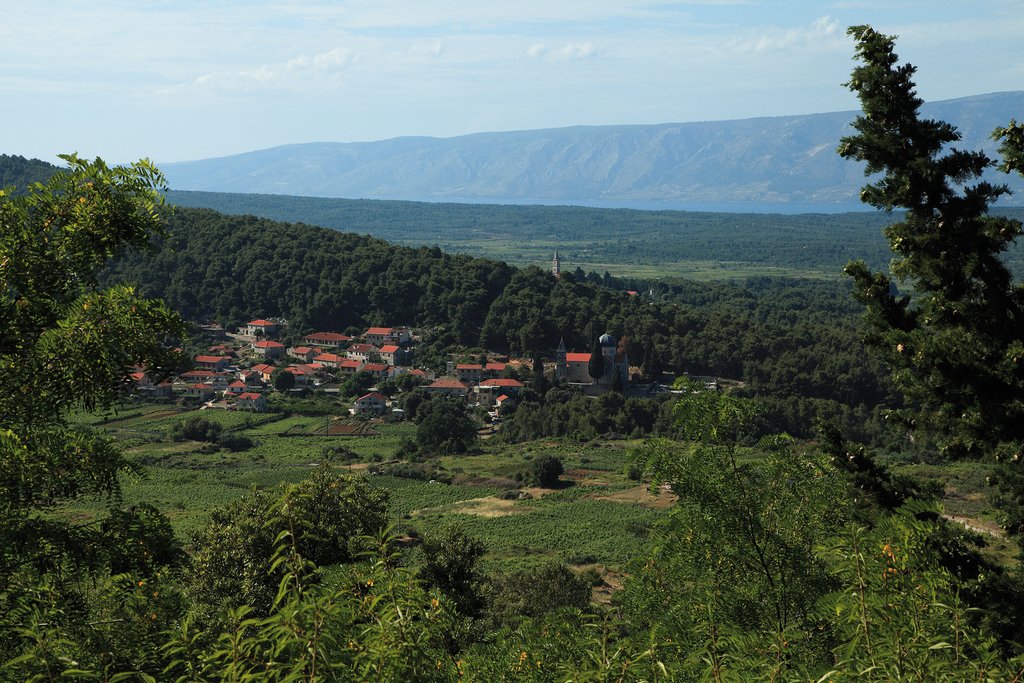
Hvar offers a diverse range of attractions and activities to cater to every taste and interest. From exploring historic towns to basking on pristine beaches, from hiking through fragrant lavender fields to indulging in local cuisine, this island paradise promises an unforgettable experience.
### Main Coastal Towns: Hvar Town & Stari Grad – A Tale of Two Cities
Hvar Town, often likened to the Côte d’Azur of Croatia, exudes a captivating Mediterranean charm. Its glamorous Riva, a waterfront promenade, embraces the yacht-filled harbor and leads to the historic core, a mesmerizing network of narrow, car-free marble streets. This medieval labyrinth is overseen by a 16th-century fortress, a silent sentinel that has witnessed centuries of history, and ancient milk-white stone houses that whisper tales of the past. It’s no wonder that Hvar Town’s allure draws in crowds of around 20,000 people a day during the peak season, making it the island’s busiest and most vibrant destination.
In contrast, Stari Grad offers a more rustic and relaxed atmosphere, catering to a more family-oriented crowd. As the island’s main port, Stari Grad rests peacefully along the sides of a deep bay. It holds the distinction of being one of Europe’s, and Croatia’s, oldest towns, boasting the standard Adriatic charms that travelers have come to expect: stone houses adorned with colorful window boxes, and narrow alleys that unexpectedly open onto small, charming squares. What’s more, to the east of the town lies the UNESCO-protected Stari Grad Plain, an agricultural landscape where the ancient Greek system of field division has been preserved almost unchanged, offering a unique glimpse into the island’s agricultural heritage.
### Quiet Coastal Towns & Interior Villages: Discovering Hidden Gems
Venture beyond the main towns and discover the quiet coastal towns of Jelsa and Vrboska, located to the east of Stari Grad. These are both delightful spots for a short visit, offering a glimpse into a more tranquil side of Hvar.
Jelsa, a former fishing village, boasts a 19th-century waterfront that is backed by an old quarter of intimate streets and squares. The town is surrounded by thick pine forests and tall poplars, providing a refreshing escape from the summer heat, and offers access to a few swimming sites that are well worth checking out.
Similarly, Vrboska is a laid-back settlement, and Hvar’s smallest. This sleepy village is nicknamed “Little Venice” for its trio of quaint bridges that span the length of the narrow inlet on which the village dwells, creating a picturesque and charming scene.
The interior of Hvar is home to a number of stone-forward villages, each offering a unique glimpse into the island’s rural heritage. Breathe in the intoxicating scent of lavender and rosemary in Brusje, located on the island’s west end. Learn how Vrbanj, Hvar’s largest village, got its start. And sample freshly-pressed olive oil and local wine from the nearby groves and vineyards of Svirče.
For a truly unique experience, weave your way uphill to the island’s middle, where you’ll find Humac, a semi-abandoned hamlet and a perfectly-preserved example of what Dalmatian rural architecture looks like. This living museum offers a poignant reminder of the island’s past and the enduring traditions of its people.
### Pakleni Islands & Beaches: A Coastal Paradise
Opposite the entrance to the Hvar Town harbor lies the stunning chain of the Pakleni islands. This collection of wooded and rocky islets is a must-see for any visitor to Hvar. The crystal-clear waters surrounding the islands are considered to be the most beautiful part of the Hvar Riviera, beckoning with their inviting turquoise hues.
The largest of the islands is Sveti Klement, which supports three villages offering accommodation, restaurants, and beaches. There’s also the clothing-optional Sveti Jerolim, offering a liberating experience for those who seek it, and the slightly larger Marinkovac, which boasts two popular beaches: the sandy Ždrilca and the lagoon-like Mlini to its north, and Uvala Stipanska at its south.
Back on Hvar, the perimeter is littered with beaches, mostly of the rocky variety. Close to Hvar Town, you can rent sun loungers and day beds, or, if you’re lucky, find your own secluded space to drop your towel and soak up the sun. Further east, there’s the spacious swath of pebble beach at Milna, where you can opt to rent a sun lounger, though there’s ample space if you’d rather simply spread out your towel.
Then there’s Uvala Dubovica, a white pebbled beach considered to be one of Hvar’s most beautiful, accessed following a footpath down a rocky hill. This secluded paradise is well worth the effort to reach.
On the northern edge of Hvar, east of Jelsa and en route to Sućuraj, are a slew of pleasant coves, like the sandy, but narrow Grebišće (it does not have a lot of shade so make sure to bring a beach umbrella). And the Glavica peninsula, east of Vrboska, offers a series of beaches, including naturist-frequented ones as well as the main destination of Soline.
### Hike, Bike, Scoot, & Watersports: An Active Adventure
Beyond sunning on the beaches, Hvar offers a host of exciting activities to pursue. Rock climbing is popular, with free climbing spots scattered around the island and open to climb all year round.
Hike the Lavender Road amid sweetly scented lavender fields and gnarled olive groves as you work your way from Stari Grad to Hvar Town, stopping to visit the historic villages of Velo Grablje and Malo Grablje. Cover more ground on a cycling tour of the Stari Grad Plain, as you complete a circuit that also includes Jelsa and Vrboska.
Rent a scooter from Hvar Town and traverse much of the island terrain, hopping on and off as you please, perhaps discovering a hidden beach you happen upon. The adventurous will want to join an ATV off-roading excursion that encompasses all of the above as well as St. Nicholas, Hvar’s tallest peak, and Sveta Nedija, a village surrounded by vineyards renowned for their difficulty to cultivate.
And of course, where there is water, there is sport. For a host of watersports like paddleboarding, jet-skiing, kayaking, sailing, snorkeling, and scuba diving, head to any nearby beach for an opportunity that suits your needs.
## Eating & Drinking on Hvar: A Culinary Journey
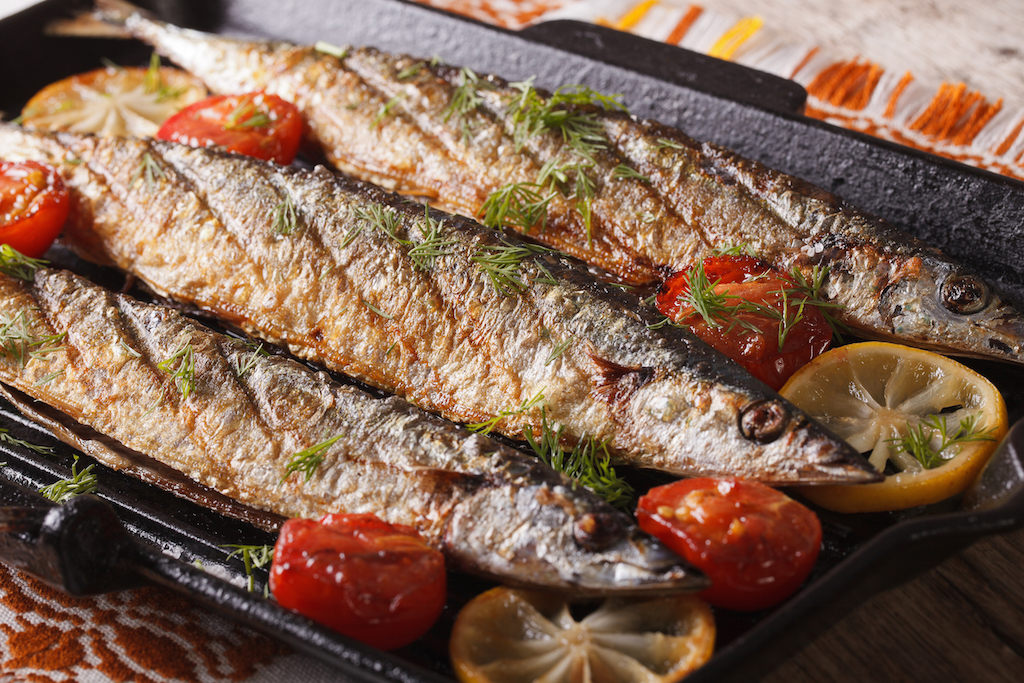
Hvar’s culinary scene is as diverse and captivating as its landscape, offering a delectable array of flavors and experiences to tantalize your taste buds.
### Where to Eat: A Gastronomic Paradise
There are dozens of places to eat, with more pricier options in Hvar Town. Feast on a full course meal from starters to dessert at Giaxa. Once a medieval palace located in the center of Hvar Town, it’s now a restaurant serving traditional Dalmatian dishes with modern European flair.
Tucked in a backstreet around the corner is Macondo. Local fish and seafood is delicious here, but order their specialty, the gregada (a fisherman’s stew with potatoes and garlic). Locals come here for the authentic Dalmatian cuisine and traditional atmosphere.
For something special, head slightly further afield. It’s worth the trek to Robinson—literally, you must hike an hour and twenty minutes to the beachside restaurant. Sitting east of Hvar Town, dine on their squid nona mikra (squid braised with onions); it’s what they’re known for.
Then, on an island a short boat ride from Hvar Town, Zori is run by a husband and wife duo serving dishes with a creative take on classic Dalmatian cuisine and offers beautiful views of the sea. Make reservations beforehand.
### What to Drink: Toasting to the Good Life
Hvar’s great weather also means it produces some of the best wines in the region. Immerse yourself in wine country less than half an hour inland from Hvar Town. Tour wineries to meet the winemakers and discover the UNESCO-protected grapes that have grown since the time of the ancient Greeks.
Take a full-day or half-day wine tour and learn about the island’s 2,400-year-old history of wine. Then hit the town to check out Hvar’s nightlife, featuring more wine bars than clubs.
Though for something more intimate, bring a bottle of wine and watch the sunset from these two scenic locales:
* **Španjola Fortress**. The short walk up to this old 16th-century fortress is worth the hike for the stunning views of Hvar Town and the Pakleni islands.
* **Tito’s Caves**. Get away from the tourists in Hvar Town and watch the sunset at these hidden-away caves. You’ll see signs for the caves at the top of the peninsula just north of Stari Grad.
This description is approximately 2789 words.
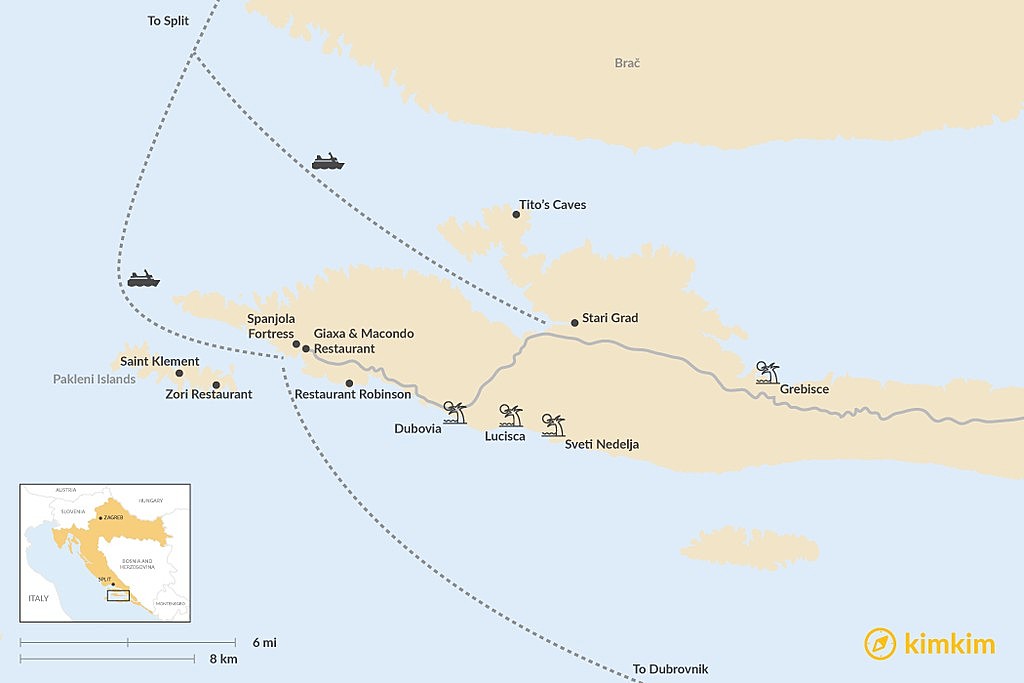
B-636

